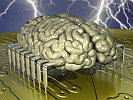Towards a Bi-Directional Neural Prostheses for the Central Nervous System |
||||||
 |
Future Directions for Bi-Directional Neural Prostheses |
|||||
What does the future hold?Currently, only a FGPA based system to emulate the natural response of the CA3 region of the hippocampus dentate -> CA3 -> CA1 cascade has been realized. There are still many challenges that need to be addressed in order to reach the ultimate goal of creating a micro-chip based implantable neural prostheses system that would be able to replace damaged regions of the hippocampus that is capable of bi-directional communication. Some of these challenges include: 1. The current system only takes in a single input, processes the information and sends out a single output. However, the multiple subpopulations of the cascade require that a bidirectional prostheses be developed that allows for multiple input and multiple outputs from the model [1]. 2. The current system of the CA3 region of the hippocampus was implemented with the use of an FPGA platform. However, in order to approach implantable sizes for the device, the system must be developed on a Very Large Scale Integration (VLSI) platform that allow for the possibility of implantation. This complex VLSI device would also allow for a multi-chip design that can process multiple inputs and deliver multiple outputs [2]. 3. The current system was tested on hippocampus slices with flat electrodes as shown previously. However, in order to implant such a device it is essential that deep penetrating electrodes be created that would allow access to the hippocampus from the surface of the brain to the stimulation target regions [2]. 4. Due to the fact that the current system was tested in vitro, it was not required that the platform be packaged. However, if a VLSI based prostheses is developed, then it is a necessity to ensure that an appropriate packaging technology be created that would allow for the integration of the VLSI chip and electrodes within a hermetically sealed device [2]. 5. Current implantable electrodes have been faced with the challenge of not being able to function within the body for extended periods of time. In order to develop a neural prostheses system for the central nervous system it is a must that a more biocompatible and robust electrode design be developed to ensure the proper functioning of electrodes for extended periods of time. | ||||||